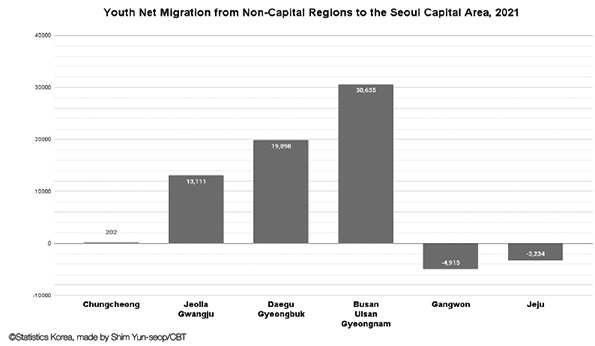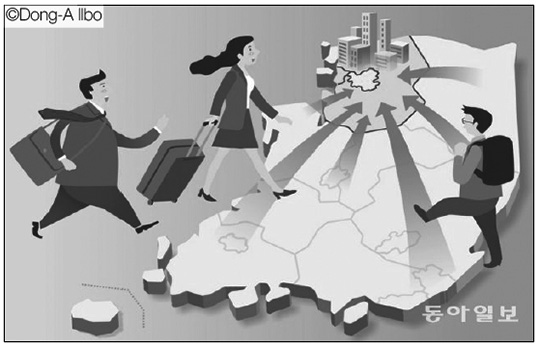
South Korea is so heavily centralized in the Seoul capital area that it is often referred to as the “Republic of Seoul.” As of 2023, although the Seoul capital area only accounts for 11.8% of the total national land area, it is home to 51% of the entire population. Moreover, 72% of the population within the Seoul capital area is concentrated in areas that make up only 17% of its total area, highlighting the severity of overpopulation in the region. Conversely, local cities are facing a crisis of extinction due to continuous population outflow and serious aging issues. As of 2023, 118 out of 228 basic local governments, accounting for 51.8%, are classified as regions at risk of population extinction, with 45 among them being in high-risk zones. Particularly, in metropolitan governments such as Jeollabuk-do, Gangwon-do, Gyeongsangbuk-do, Jeollanam-do, and Chungcheongnam-do, more than 80% of the areas are at risk, and in Chungcheongbuk-do and Gyeongsangnam-do, the figure exceeds 70%. This indicates that the majority of local governments are facing the risk of extinction. The disparity between the Seoul capital area and non-capital regions is evident not only in population proportions but also in economic terms. In 2021, the Seoul capital area accounted for 52.8% of the national Gross Regional Domestic Product (GRDP), marking a historical high. In contrast, non-capital regions accounted for only 47.2%, indicating a widening economic gap between the two. Moreover, according to the Busan Chamber of Commerce & Industry, 91% of the headquarters of South Korea’s top 100 companies are situated in the Seoul capital area. This underscores the significant concentration of businesses in the Seoul capital area. This population and economic disparity have led to gaps in social infrastructure, such as healthcare, transportation, and cultural facilities. For example, excluding museums, 9 out of 14 national exhibition and performance facilities are located in Seoul, and as of 2020, 89.1% of the total sales in the cultural content industry, including music, games, and movies are concentrated in the Seoul capital area. In the medical field, the number of private practice doctors in the Seoul capital area exceeds that of the entire non-capital regions, showing a significant healthcare gap. This crisis is not limited to small and medium-sized non-capital regions. Busan, Korea’s second-largest city, has already been surpassed by Incheon in terms of GRDP, and its population is also on a declining trend. It is predicted that in ten years, Incheon will surpass Busan in population as well. The current situation, where even Busan is in crisis, is considered to symbolically represent the overall crisis facing the non-capital regions.

The direct cause of the overpopulation in the Seoul capital area and the extinction crisis of non-capital regions is the large-scale migration of the population, especially the youth, from non-capital regions to the Seoul capital area. More concerning is the fact that the majority of those leaving non-capital regions are young people. According to the national statistical informational service of Statistics Korea, the net migration of people in their 20s to Seoul, Gyeonggi, and Incheon from 2013 to 2022 was recorded at 591,000. During the same period, the total net inflow of population to the Seoul capital area was 279,000, meaning that the influx of people in their 20s offset the outflow of other age groups to the Seoul capital area. Young people from non-capital regions who go up to the Seoul capital area tend to settle there, build families, and their children grow up and reside in the Seoul capital area, further exacerbating the overpopulation issue. Meanwhile, non-capital regions suffer from a outflow of the youth population and intensified aging, leading to a decline in regional vitality, a decrease in the working-age population, a contraction in regional economic activity, and a lack of investment in the region.
Young people say that there are some reasons why they must leave their hometown for the Seoul capital area. The most common reasons are university and employment. In many non-capital regions, the youth population first significantly moves out during the university entrance age of 20-24, with many heading to university in the Seoul capital area. They stated moving to the Seoul capital area due to the positive social perception of universities in Seoul. Jo Hyun-ji, who moved from Uljin, Gyeongsangbuk-do to Seoul for university, mentioned, “There were no universities in my hometown, so to attend an university, I had to move to another region. Universities in Seoul are generally perceived better than those in non-capital regions.” Sim Hye-won from Gumi, Gyeongsangbuk-do, also moved to Seoul for university. She said, “I had a desire to leave the area I was living in. Since socially recognized universities are concentrated in Seoul, it was natural for me to attend a university in the Seoul capital area. Most adults around me also preferred universities in the Seoul capital area.”
The outflow of young people from non-capital regions increases again at the age of employment. Na Su-mi, a graduate of CBNU, from Chungju, Chungcheongbuk-do, is employed in Seoul. She said, “There are a wider range and greater number of job opportunities in Seoul than in non-capital regions. It is not just about jobs, but Seoul also offers more opportunities to gain various experiences and meet people.” Kwon Hui-ju, a job seeker residing in Eumseong, Chungcheongbuk-do, also feels the need to move to the Seoul capital area for job hunting. She stated, “The Seoul capital area offers a wider range of career choices compared to non-capital regions. I am hoping to work in the IT sector, and many IT companies are concentrated in the Seoul capital area, so moving there seems like a natural decision for me.” Young people who moved to the Seoul capital area for university also prefer to stay their hometowns. Sim said, “My desired career path is in the clinical trial field, so I need to stay in the Seoul capital area, which has many university hospitals. Most hospitals are concentrated in Seoul, and working there allows access to various cases and the ability to build a specialized career. This is the main reason I will continue to stay in Seoul.”
Additionally, the youth commonly cite the superior infrastructure of the Seoul capital area as another reason for staying there. They praised the well-developed public transportation system and excellent cultural facilities compared to non-capital regions. Jo explained, “In Seoul, I can easily access cultural activities that I could not enjoy when living in non-capital regions. I enjoy watching musicals and concerts, and these cultural activities are almost exclusively available in Seoul. Also, there were no movie theaters in my hometown, so I had to go to a neighboring city to watch movies, and even then, the theaters were too small to play the movies I wanted to see.” Kwon also mentioned, “Most major and minor events are held in Seoul, and the subway is an excellent public transportation system with short intervals and no traffic congestion. Having access to such infrastructure is a very attractive opportunity.”
Despite currently residing in Seoul, the youth expressed a desire to return to their hometown cities if appropriate conditions are met. Sim emphasized, “Most students from non-capital regions, including me, really like their hometowns and want to work there. However, most prefer the Seoul capital area due to practical factors like job opportunities. Therefore, if these issues are addressed through policies, there would be a willingness to return.” Na also stated, “In Seoul, both rent and food expenses are much higher, making living costs almost double, compared to non-capital regions. If I can find a suitable job in non-capital regions, I would like to go back.” The government is also conducting several local youth support projects in response to these needs. Notable projects include the “Local Youth Employment Project” and the “Youth Village Project.” The Local Youth Employment Project aims to encourage youth employment within the local area, with local governments recruiting participating companies and matching suitable jobs for young people while providing financial support to the companies. The Youth Village Project provides young people with opportunities to stay in the local area for a certain period of time and supports their settlement in the region through job experiments and community networking, using local resources to create new jobs. However, there are calls for the government to use stronger incentives in addition to these policies. Professor Lee Hyang-soo, Dept. of Public Administration at Konkuk University suggests making non-capital regions more attractive for employment, saying, “Although public institutions have been relocated to the regions, there is a need to continue moving them. Moreover, it is suggested that the system of recruitment preferences for youth who graduates from local universities in these public institutions should be significantly expanded, so that they can settle in the regions where they attended university.” Prof. Lee also pointed out the infrastructure gap between the capital and non-capital regions, emphasizing, “Living infrastructure should be built on a metropolitan scale to enjoy various infrastructures beyond the boundaries of small cities. Efforts should be made through cooperation between nearby local governments to build such metropolitan infrastructure.” She added that such methods should be used to expand factors that encourage young people to stay in non-capital regions.
The outflow of the youth population from non-capital regions is a complex issue arising from various problems, and building infrastructure and creating jobs are not easy tasks. However, the fact that young people want to return to their hometowns is a hopeful sign. Accordingly, more active policy intervention by the government and the creation of local-centered jobs is important to realize the return of the youth to their hometowns.

By Shim Yun-seop
sys091109@chungbuk.ac.kr


 All
All Feature
Feature






 Shim Yun-seop
Shim Yun-seop











